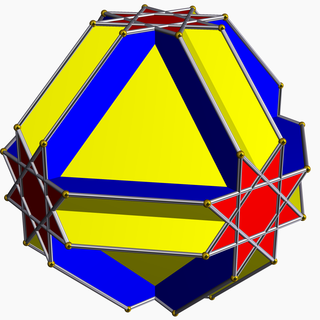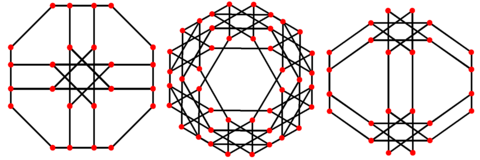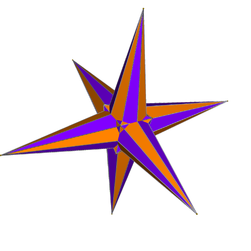Cubitruncated cuboctahedron
| Cubitruncated cuboctahedron | |
|---|---|
 | |
| Type | Uniform star polyhedron |
| Elements | F = 20, E = 72 V = 48 (χ = −4) |
| Faces by sides | 8{6}+6{8}+6{8/3} |
| Coxeter diagram |     |
| Wythoff symbol | 3 4 4/3 | |
| Symmetry group | Oh, [4,3], *432 |
| Index references | U16, C52, W79 |
| Dual polyhedron | Tetradyakis hexahedron |
| Vertex figure |  6.8.8/3 |
| Bowers acronym | Cotco |

In geometry, the cubitruncated cuboctahedron or cuboctatruncated cuboctahedron is a nonconvex uniform polyhedron, indexed as U16. It has 20 faces (8 hexagons, 6 octagons, and 6 octagrams), 72 edges, and 48 vertices,[1] and has a shäfli symbol of tr{4,3/2}
Convex hull
Its convex hull is a nonuniform truncated cuboctahedron.
 Convex hull |  Cubitruncated cuboctahedron |
Orthogonal projection

Cartesian coordinates
Cartesian coordinates for the vertices of a cubitruncated cuboctahedron are all the permutations of
- (±(√2−1), ±1, ±(√2+1))
Related polyhedra
Tetradyakis hexahedron
| Tetradyakis hexahedron | |
|---|---|
 | |
| Type | Star polyhedron |
| Face |  |
| Elements | F = 48, E = 72 V = 20 (χ = −4) |
| Symmetry group | Oh, [4,3], *432 |
| Index references | DU16 |
| dual polyhedron | Cubitruncated cuboctahedron |

The tetradyakis hexahedron (or great disdyakis dodecahedron) is a nonconvex isohedral polyhedron. It has 48 intersecting scalene triangle faces, 72 edges, and 20 vertices.
Proportions
The triangles have one angle of , one of and one of . The dihedral angle equals . Part of each triangle lies within the solid, hence is invisible in solid models.
It is the dual of the uniform cubitruncated cuboctahedron.
See also
References
- ^ Maeder, Roman. "16: cubitruncated cuboctahedron". MathConsult. Archived from the original on 2015-03-29.
- Wenninger, Magnus (1983), Dual Models, Cambridge University Press, ISBN 978-0-521-54325-5, MR 0730208 p. 92
External links
- Weisstein, Eric W. "Cubitruncated cuboctahedron". MathWorld.
- Weisstein, Eric W. "Tetradyakis hexahedron". MathWorld.
- http://gratrix.net Uniform polyhedra and duals
- v
- t
- e















